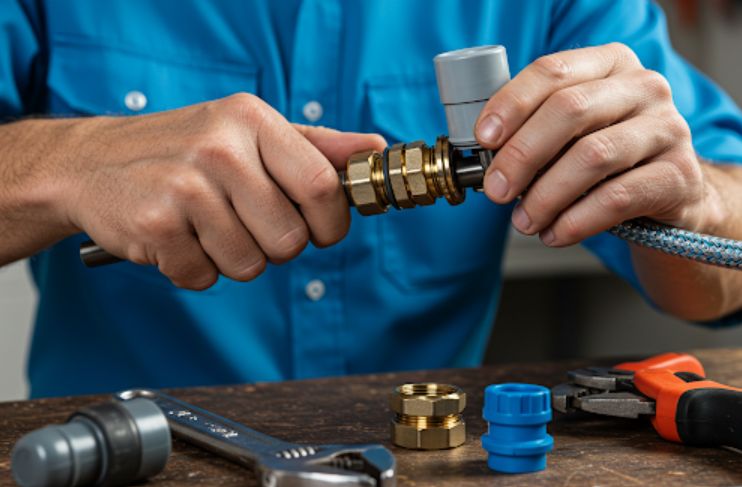Reusable hose fittings are a game-changer for anyone working with hydraulic hoses. They offer a cost-effective, easy-to-use, and flexible solution for creating custom hose assemblies.
Whether you’re a DIY enthusiast tackling a home project, a mechanic working on vehicles, or an industrial professional maintaining complex machinery, reusable fittings can save you time and money.
This guide will walk you through the process of installing them step-by-step.
Tools and Materials Needed
Gather the necessary tools and materials before you begin:
➡️ Wrenches: A set of appropriately sized wrenches, including adjustable wrenches, is crucial for tightening the fittings.
➡️ Vise: A vise helps hold the hose securely while you work.
➡️ Hose Cutter: A specialized hose cutter ensures a clean, straight cut. A sharp utility knife can work in a pinch, but a hose cutter is recommended.
➡️ Lubricant: A small amount of lubricant (like petroleum jelly or a silicone-based lubricant) can ease the fitting process.
➡️ Safety Glasses: To safeguard your eyes, always wear safety glasses.
➡️ Gloves: Gloves can protect your hands and provide Sure, here is a complete blog post on how to install reusable hose fittings:
Step-by-Step Guide to Installing Reusable Hose Fittings
Reusable hose fittings are a type of fitting that can be reused multiple times, making them a cost-effective and environmentally friendly alternative to traditional fittings. They are also easy to use and can be installed in a variety of applications.
Who Can Benefit from Using Reusable Hose Fittings?
Reusable hose fittings are a great option for anyone who works with hoses, including DIYers, mechanics, and industrial workers. They are also a good choice for anyone who wants to save money and reduce waste.
1. Tools and Materials Needed
Here are the tools and materials you will need to install reusable hose fittings:
Tools:
➡️ Wrenches (metric and standard)
➡️ Vise
➡️ Hose cutter
➡️ Lubricant
Materials:
➡️ Reusable hose fittings
➡️ Hoses
2. Types of Hoses Compatible with Reusable Fittings
Reusable hose fittings can be used with a variety of hoses, including hydraulic hoses, pneumatic hoses, and vacuum hoses.
There are several different types of reusable hose fittings, including:
➡️ JIC fittings
➡️ NPT fittings
➡️ BSP fittings
3. Preparing the Hose
Before you can install a reusable hose fitting, you need to prepare the hose. This involves:
1. Measuring and cutting the hose to the required length.
2. Ensuring a clean, straight cut to prevent leaks.
3. Removing any debris from the hose end.
4. Disassembling the Fitting
Reusable fittings typically consist of three parts: a socket, an insert, and a nut. To disassemble the fitting, you will need to:
1. Unscrew the nut from the socket.
2. Remove the insert from the socket.
5. Installing the Fitting on the Hose
To install the fitting on the hose, you will need to:
1. Insert the hose into the socket.
2. Insert the insert into the socket.
3. Screw the nut onto the socket.
Tips to Ensure a Secure and Leak-Proof Connection
➡️ Make sure the hose is properly seated in the socket.
➡️ Use a lubricant to help prevent leaks.
➡️ Tighten the nut to the proper torque specifications.
6. Tightening and Securing the Fitting
Once the fitting is in place, you will need to tighten it. This can be done using a wrench or a vise. It is important to tighten the fitting to the proper torque specifications to prevent leaks.
7. Testing for Leaks and Performance
Once the fitting is installed, you should test it for leaks. To do this, you can pressurize the hose and look for any leaks. If you find any leaks, you will need to tighten the fitting or replace the gasket.
8. Maintenance and Reuse Tips
Reusable hose fittings can be reused multiple times if they are properly maintained. To maintain your fittings, you should:
➡️ Clean the fittings regularly.
➡️ Store the fittings in a cool, dry place.
➡️ Inspect the fittings for damage before each use.
Conclusion
Reusable hose fittings are a great way to save money and reduce waste. They are also easy to install and can be used in a variety of applications. If you are not sure how to install reusable hose fittings, you can always consult with a professional.
If you have any questions about reusable hose fittings, please feel free to leave a comment below. We would also love to hear about your experiences with installing reusable hose fittings.
Post time: Feb-26-2025


